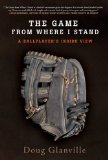The Game From Where I Stand: A Ballplayer’s Inside View — by Doug Glanville
 Anytime a ballplayer’s memoir arrives in my mailbox, I am immediately suspect and weary of what the pages might contain. Self-praise, guarded secrets, and often an over-hyped book that fails to live up to the marketer’s promises.
Anytime a ballplayer’s memoir arrives in my mailbox, I am immediately suspect and weary of what the pages might contain. Self-praise, guarded secrets, and often an over-hyped book that fails to live up to the marketer’s promises.
Such is not the case with Doug Glanville‘s debut book, The Game From Where I Stand: A Ballplayer’s Inside View.
Fortunately, the hype machine did not reach me before the book did – the good folks at Henry Holt and Company managed to slip this one in my mailbox without much fanfare, which I believe was a smart move on their part, as it allowed my to dive into it without any preconceived notion of just how great or scandalous it might be.
Glanville, a veteran of nine seasons in the big leagues, brings a remarkably understated amount of insight to his book, which is a refreshing thing in this era of Tweeted scandals and sound bites dominating the nightly news. He does not speak with the trepidation of someone who needs to be wary of offending Hall of Fame voters, nor does he write with the rampant disregard of former players who are seeking attention, one Mr. Jose Canseco being a prime example. Rather, he knows that setting every bridge he has ever crossed on fire will do him no good, yet guarding every sacred secret in the game is no path to post-baseball success.
The book ended up being split into two distinct parts for me — the first six chapters, which cover Glanville’s playing career, and the following five chapters in which he allows his intellectual and insightful side to emerge as he reflects on life after baseball and casts a critical yet tempered eye on the state of baseball today.
The difference between the first six chapters and the latter five is remarkable — Glanville’s pragmatism in the first half about choosing gloves and the recognition that comes with being a professional athlete in the first half takes on a much deeper tone in the second, as illustrated in his trip to buy a luxury car and his commentary on the struggles that pain athletes once the jersey has been ‘ripped from their backs.’
Glanville comments on a number of topics in the second half, from promiscuity on the road to steroids, as well as the way athletes are treated because of their job and the wake-up call that is finding life after baseball, and addresses all of them with an insight that is surprisingly deep. The University of Pennsylvania graduate and occasional columnist for the New York Times shows an ability to provide fair criticism without overstepping his bounds, thus providing the reader a look at the game of baseball that I have rarely seen. This isn’t the talking head kind of commentary that is seen on television, nor is it the soapbox pontificating that is heard on radio or the salacious say-it-first-prove-it-later commentary often found on blogs; rather this is insight from a credible source who has the ability to communicate in well thought out, coherent sentences.
This is one of the better baseball memoirs that I have had the pleasure of reading, and I would encourage you to take a chance on it as well. While the first half of the book may leave you wondering why you picked up the book, the second half will quickly answer that question and leave you wanting to hear more from Mr. Glanville, something that I hope we are able to do for quite some time.